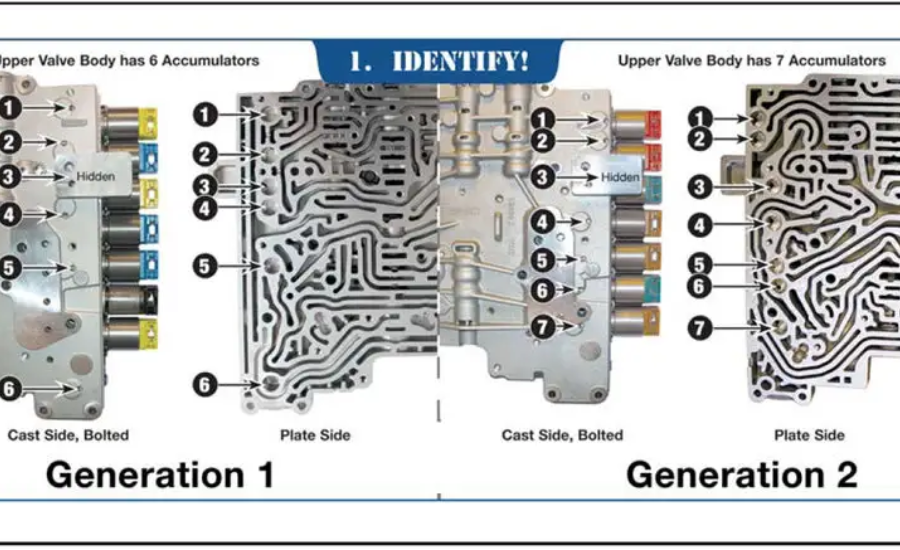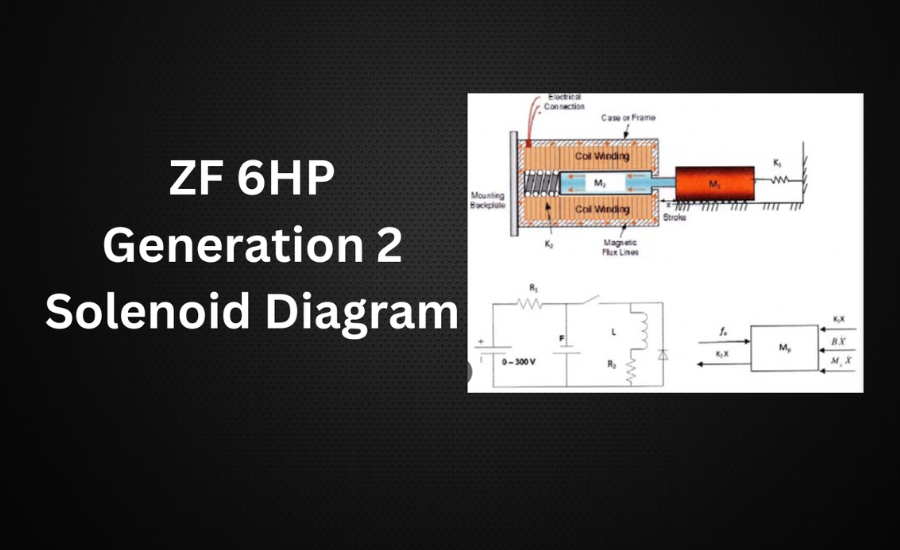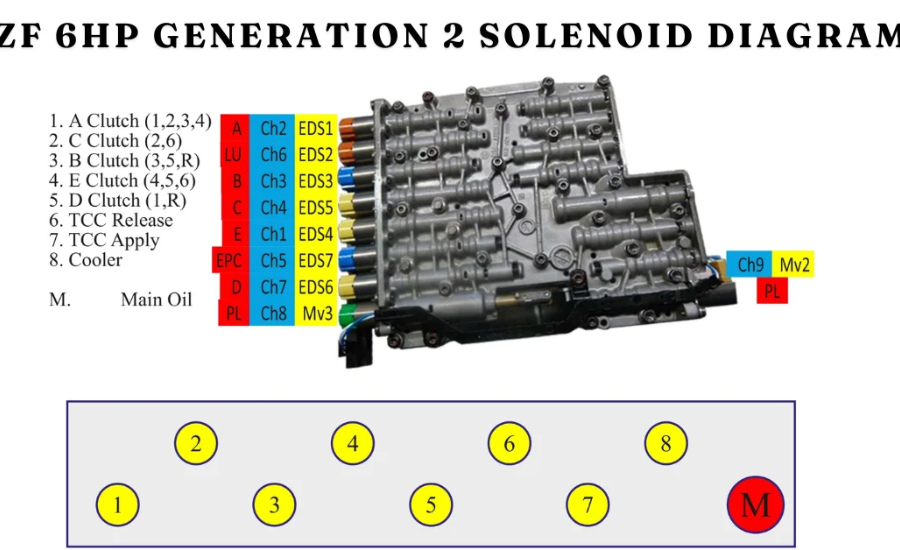zf 6hp generation 2 solenoid diagram reputation for durability and seamless operation has earned it the admiration of car enthusiasts and mechanics alike. However, despite its strengths, the transmission is still subject to the usual wear and tear that affects all mechanical systems. One area that often requires attention is the solenoids. These small yet essential components play a critical role in the transmission’s operation by regulating the flow of transmission fluid and enabling smooth gear shifts. When solenoids fail or malfunction, they can disrupt the entire driving experience, leading to issues like erratic shifting or transmission slippage. This article will explore the importance of solenoids in the ZF 6HP Generation 2 transmission, guide how to read a solenoid diagram and explain why understanding these diagrams is crucial for effective troubleshooting and maintenance.
What is a Solenoid in a Transmission?

In the zf 6hp generation 2 solenoid diagram, these solenoids play a vital role in managing gear shifts, ensuring they occur smoothly and efficiently. By regulating the flow of transmission fluid, solenoids determine which gears are engaged at any given time, allowing for precise and timely gear changes. When a solenoid is activated, it opens a pathway for transmission fluid to move to specific parts of the transmission, facilitating the engagement of various gears.
Common Issues with Solenoids
Like any mechanical part, solenoids can develop issues over time, leading to various transmission problems. Common signs of faulty solenoids include:
- Erratic Shifting: The transmission might shift unpredictably, such as shifting at unexpected times, skipping gears, or struggling to shift into the appropriate gear.
- Stalling or Hesitation: The vehicle may hesitate or delay when accelerating from a stop, or the engine might stall during gear changes.
- No Shifting or Stuck in Gear: In some cases, the transmission may become stuck in a specific gear or fail to shift altogether, indicating a more serious solenoid malfunction.
These symptoms suggest that the solenoids are not operating as they should, potentially requiring diagnostic testing and, if necessary, replacement to restore proper transmission function.
How to Use the ZF 6HP Generation 2 Solenoid Diagram

The ZF 6HP Generation 2 solenoid diagram is an invaluable resource for anyone seeking to understand or troubleshoot this specific transmission system. Here’s how to make the most of the solenoid diagram:
- Identify the Components: The diagram will feature various solenoids, usually marked with letters or numbers. Each solenoid has a specific function, such as controlling shifts between certain gears or managing the transmission fluid pressure. Familiarizing yourself with these labels helps you understand which solenoid performs each role.
- Understand the Connections: The diagram provides details on how each solenoid integrates with the rest of the transmission system. This includes the electrical circuits that power the solenoids and the fluid pathways they control. Understanding these connections is crucial for diagnosing issues and ensuring the transmission operates smoothly.
- Trace the Fluid Flow: Solenoids are key to directing the flow of transmission fluid, which is essential for proper gear shifting. By studying the diagram, you can visualize how the fluid moves throughout the transmission and how each solenoid influences this flow. This understanding can help you anticipate how changes in solenoid operation might affect transmission performance.
- Use for Troubleshooting: If you’re facing transmission problems, the solenoid diagram can be a vital troubleshooting tool. For instance, if the vehicle struggles to shift into a specific gear, you can consult the diagram to identify which solenoid is responsible for that gear’s engagement. This information allows you to target the right solenoid for testing or replacement, potentially resolving the issue more efficiently.
By utilizing the ZF 6HP Generation 2 solenoid diagram effectively, you can gain a deeper understanding of the transmission system and enhance your ability to diagnose and fix transmission-related problems.
Diagnostic Tips for Solenoid Issues

When utilizing the solenoid diagram for diagnosing transmission issues, it’s important to follow these key tips to ensure accurate troubleshooting:
- Inspect Electrical Connections: Begin by checking that all electrical connections to the solenoids are properly secured and free from any signs of corrosion or damage. Poor or corroded wiring can lead to solenoid malfunctions, causing issues with gear shifting and transmission performance.
- Conduct Solenoid Testing: Utilize a multimeter to measure the electrical resistance of each solenoid. This diagnostic step can help identify solenoids that are failing or have already failed.
- Listen for Audible Clicks: Solenoids usually produce a clicking sound when they are activated, which indicates that they are functioning properly. If you do not hear this clicking sound during gear shifts, it may signal a problem with the solenoid in question, suggesting that it may not be engaging or disengaging as intended.
By following these steps and using the solenoid diagram effectively, you can more accurately diagnose and address issues with the ZF 6HP Generation 2 transmission, ensuring it continues to operate smoothly.
Maintenance and Replacement

Regular maintenance of the ZF 6HP Generation 2 transmission is crucial in preventing issues with the solenoids and ensuring the overall health of the transmission system. Routine tasks, such as changing the transmission fluid at recommended intervals, help keep the solenoids functioning properly by maintaining clean and effective lubrication. Additionally, periodic inspections of the solenoid wiring and electrical connections are essential to identify and address any signs of wear, corrosion, or damage that could lead to solenoid malfunctions.
If a solenoid replacement becomes necessary, consult the solenoid diagram to accurately locate the specific solenoid and follow the recommended replacement procedure. Using the correct tools and techniques will help avoid any potential damage during the replacement process. It is also important to use high-quality replacement solenoids and parts to ensure that the transmission continues to operate reliably and efficiently over the long term. Adhering to these maintenance practices will help extend the lifespan of your ZF 6HP Generation 2 transmission and enhance your vehicle’s overall performance.
FAQS
1. What is the role of solenoids in the ZF 6HP Generation 2 transmission?
Solenoids are electrically operated valves that regulate the flow of transmission fluid within the ZF 6HP Generation 2 transmission. They play a critical role in managing gear shifts by controlling which gears are engaged, ensuring that shifts are smooth and efficient. Proper functioning of solenoids is essential for maintaining the overall performance and reliability of the transmission.
2. How can I tell if a solenoid is malfunctioning?
Common symptoms of a malfunctioning solenoid include erratic shifting (such as unexpected or skipped gear changes), stalling or hesitation when accelerating, the transmission being stuck in a particular gear, and the activation of the transmission warning light on the dashboard. If you notice these issues, it’s likely that one or more solenoids may be faulty and require diagnostic testing.
3. How do I use the ZF 6HP Generation 2 solenoid diagram?
The solenoid diagram helps identify the location and function of each solenoid within the transmission.
4. What steps should I take to troubleshoot solenoid issues?
Start by inspecting all electrical connections to the solenoids for signs of corrosion or damage. Use a multimeter to test the electrical resistance of each solenoid to detect failures. Listen for the characteristic clicking sound that solenoids make when activated; a lack of this sound can indicate a problem.
5. What maintenance practices can help prevent solenoid problems?
Regular maintenance is key to preventing solenoid issues. This includes changing the transmission fluid at recommended intervals to keep the fluid clean and reduce the risk of debris that can affect solenoid performance.
Conclusion
However, like all mechanical systems, it requires regular maintenance to ensure optimal functionality. Solenoids play a vital role in the transmission’s operation, controlling the flow of fluid and enabling precise gear shifts. Understanding the function and maintenance of these solenoids is crucial for anyone looking to maintain the health of their ZF 6HP Generation 2 transmission. By using solenoid diagrams effectively, performing routine maintenance, and addressing issues promptly, vehicle owners and mechanics can help ensure the longevity and reliability of their transmission systems.
Stay in touch for more updates and alerts:AiyiFan!
